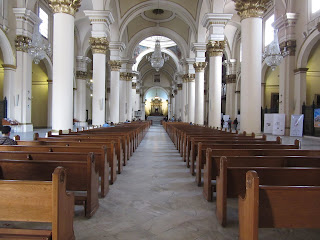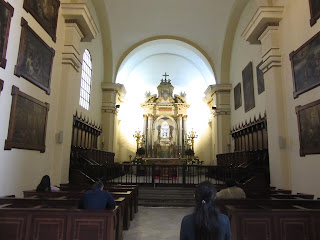After visiting the Museo del Oro for the last couple of
hours,
It was the church where the Spaniards had taken the indigenous people to convert. If they didn’t choose that, they were then taken to Santander Square across the street and beheaded. The Church, built between 1557 and 1627, was Bogota’s oldest surviving church.
From the outside, it looked like a humble little country town
chapel, lost in the middle of busy downtown Bogota. But as soon as we entered, it was impossible not to be immersed in the most outstanding explosion of 16th century Spanish Baroque: the wood carvings fully covered with gold leaf, the
smell of candles burning by hundreds in front of every altar but especially the bleeding Christ and the mourning virgin helped transport us to
the Spanish colonial times. The extraordinary 17th century gilded main
altarpiece was Bogota’s largest and most elaborate piece of art of its kind. I couldn't get any close up shots because of the no photos policy so you'll have to take my word for how special it was!
After that, we needed a break and had a bite at the McDonald’s, the location where the Socialist leader Gaitan was killed in 1948 and whose death sparked widespread riots known as El Bogotazo. It was the only Mickey D's in the world we’ve been to where an employee came up afterwards and asked how our food was as is done in a restaurant! The young woman was so very friendly and taught us a few words in Spanish while we did the same with her English which was pretty non-existent except for a perfectly said “Come on baby” when I asked her to open up the locked bathroom!
Fascinating just walking down the street and coming across a couple dancing the tango. The closest I'd ever come to watching the exquisite dance before was on the Dancing with the Stars TV show!
Donut carts and stores were all over Bogota; we even spotted donuts being sold out of a van! Not surprisingly, Dunkin Donuts had a presence in the donut-happy capital.
While Steven popped in the local Exito grocery store to get
a Coke, I watched this man and his dancing and singing marionette in absolute
fascination!
Even I recognized the song 'Gloria' and a couple of the Spanish songs he 'sang' which had
been translated from English. I could have stood and watched him/them for hours
– Steven not so much!
This same couple, dressed in what seemed like identical clothes from yesterday, didn't appear to have moved from their spot at the Cathedral's 'false door' where we'd seen them yesterday! Perhaps they'd needed to escape from one of the long Masses or weren't allowing others to leave via this door!
This street musician at the end of the pedestrian street by the square reminded me of a younger Leonard Cohen. Any woman hearing this troubadour would have swooned listening to his exquisite voice!
Large squares and pigeons just seem to go hand in hand, I think!
The Catedral Primada or Primary Cathedral stood on the place where the first Mass may have been celebrated when Bogota was founded in 1538 although some historians argue that honor goes to Plazoleta del Chorro Quevedo, a couple of blocks away.
The original, simple thatched hut was replaced by a succession of
buildings that either collapsed due to poor construction or earthquakes. The
current building was successfully completed in 1823 but it was partially
destroyed in the Bogotazo riots of 1948. Unlike most Bogota churches, its
spacious interior had relatively little ornamentation.
The magnificent organ:
There were side niches with elaborate paintings and statues of holy and historical saints along each side of the length of the church.
The tomb of Jimenez de Quesada, Bogota’s founder, was in the largest chapel and only visible behind large, iron
For us, the religious gem on the square was not the
Cathedral but rather the Capilla del Sagrario, a small Baroque cathedral,
literally next door.
It had six lovely paintings by Gregorio Vasquez.
In case you’re wondering, no, we still hadn’t had enough of
visiting churches that afternoon and walked a couple of blocks to the Iglesia Museo de Santa Clara, one of
Bogota’s mostly richly decorated churches and almost as old as Iglesia de San
Francisco.
The very unassuming entrance was through the side door.
Now run as a museum by the government, the church brought tears to my eyes seeing its overwhelming beauty as soon as we entered. I read in our travel guide that most visitors pass on seeing this stunning church because of the entry fee – all of $2 if you please – and because of all the other free churches from the same era. What a huge loss in my opinion!
The Santa Clara Museum was in the old church of the Royal Convent of Santa Clara, founded in 1629 by the Archbishop of Bogota. The former church was one of the oldest churches in the city and belonged to the Poor Clares until 1861 when the nuns were forced to leave the convent and the church because of a government confiscation law.
The Colombian government bought the old church in 1968 and established a religious art museum but it wasn't opened until 1983.
The Presidential Palace was right across the street from the church.
A late-afternoon view of the Plaza showing the Cathedral on the left and the tiny Capilla del Sangaria right next to it:
Street scenes as we walked through more of downtown to catch
the funicular to Monserrate.
We stopped to grab what turned out to be a huge turkey sub that cost less than $2.
Cerro de Monserrate or Monserrate Hill was one of the most well-known images of Bogota, famous for the church at the top of its hill which offers the best views of the city. It was also convenient for its convenient point of reference in the city as it was visible from most parts of the Bogota savanna or valley. Many people, mainly locals, reached the top by walking about an hour but that wasn't an option for us as the trail was closed for maintenance every Tuesday so we took the funicular or cable car up from this building.
The funicular took us up into the high hills to an elevation of about 10,300 feet. We were so lucky that there were only four of us on the funicular so we each had awesome views of the city from the front as the sun was about to set.
Our first, up close look of the church:
Traveling up by funicular up from Bogota at 8,500 feet and then ending up two thousand feet higher was just amazing. Just the walk up the hill to the church and the view took our breath away, quite literally too! One of my favorite photos:
As we stepped off the funicular, we made directly for the church that we'd seen from afar since first arriving in Bogota. It was erected after the original chapel was destroyed by an earthquake in 1917.
The church was a major mecca for pilgrims because many miracles have been attributed to the statue of the Fallen Christ on the altar dating from the 1650s.
The peaceful Chapel of the Virgin of Monserrate:
Behind the church was a path to church offices and shops.
A combination of the altitude and not eating or drinking enough water affected Steven here and he got quite woozy and he had to sit down for a bit. We both wondered how he would do at the even higher altitudes in some places in Peru and Bolivia we're going. We'll have to take it very carefully and/or change some of our plans.
On another large hill across from Monserrate was a huge statue which looked other worldly to me as the clouds rolled in. I saw no reference to it in any of my travel literature about Bogota, however.
As we made our way from the church, we followed a path that had beautiful gardens and the Stations of the Cross which allowed for prayer and contemplation.
Ironically, the best shot of the sunset was only available after paying to use the facilities!
Next post: Mystical Laguna Guatavita.
Posted on September 28th, 2107, from Quito, Ecuador.








































































No comments:
Post a Comment